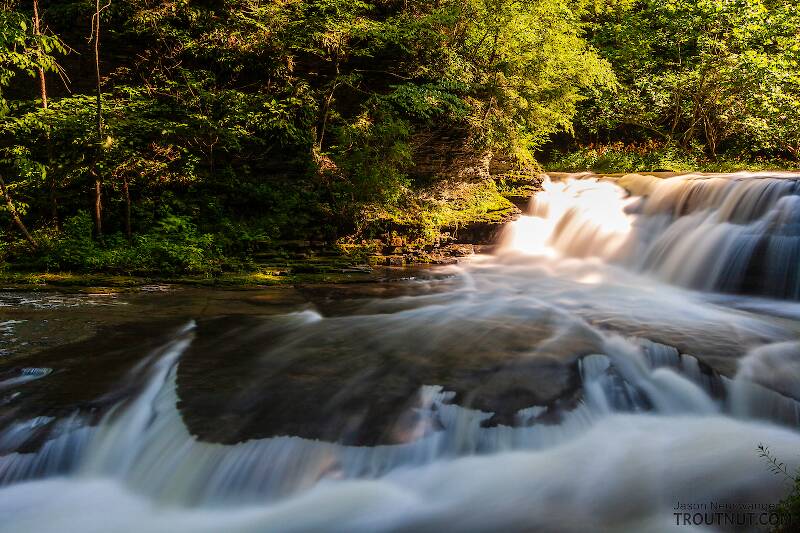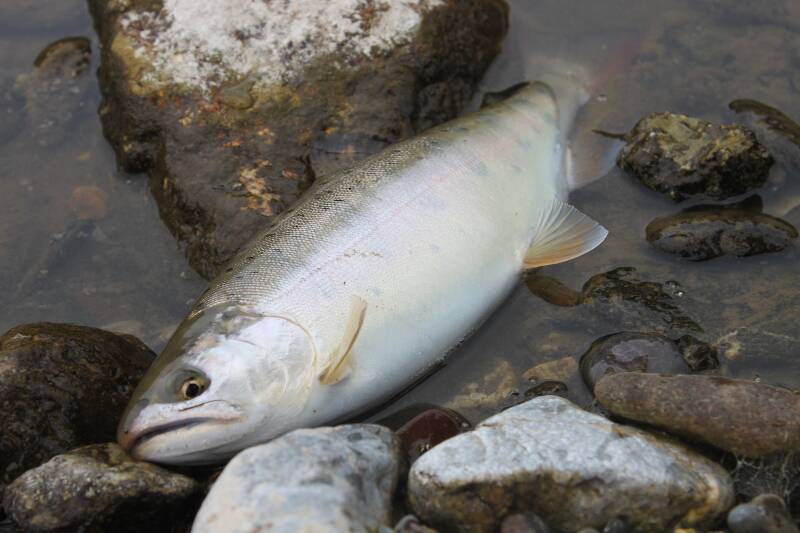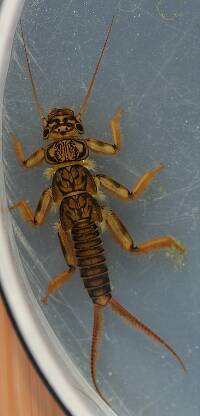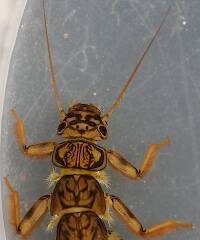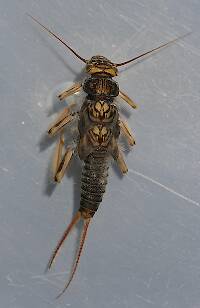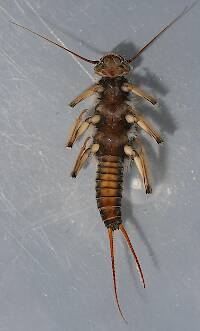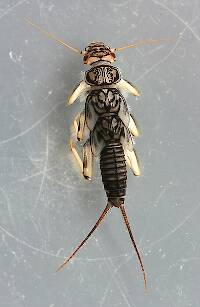
Blue-winged Olives
Baetis
Tiny Baetis mayflies are perhaps the most commonly encountered and imitated by anglers on all American trout streams due to their great abundance, widespread distribution, and trout-friendly emergence habits.
Featured on the forum

I was not fishing, but happened to be at an unrelated social event on a hill above this tiny creek (which I never even saw) when this stonefly flew by me. I assume it came from there. Some key characteristics are tricky to follow, but process of elimination ultimately led me to Sweltsa borealis. It is reassuringly similar to this specimen posted by Bob Newell years ago. It is also so strikingly similar to this nymph from the same river system that I'm comfortable identifying that nymph from this adult. I was especially pleased with the closeup photo of four mites parasitizing this one.

Troutnut is a project started in 2003 by salmonid ecologist Jason "Troutnut" Neuswanger to help anglers and
fly tyers unabashedly embrace the entomological side of the sport. Learn more about Troutnut or
support the project for an enhanced experience here.
Epeorus on Jun 23, 2014June 23rd, 2014, 12:31 pm EDT
New to this site but figured someone may have thoughts.
I have been fishing the Roaring Fork in Colorado between Carbondale and Two Rivers for about 8 years now. However, the bug life on the river is a total mystery to me and as hard as I try I can't seem to find any info for this part of the river.
I've taken kick samples up and down the river and here's what I seem to have found, but can't figure out how to correlate this to what all the fly shops say:
1. The most prolific mayfly nymph seems to be a baetis.
2. I don't seem to find many ephemerid nymphs - so what the heck is the PMD hatch they all talk about? I should mention that in about 250 days on the river I have yet to see anything resembling a PMD hatch.
3. Is the bigger "melon" PMD one sees fluttering around occassionally an Epeorus Longimanus? Seem to kick up quite a few Epeorus nymphs.
4. What the heck is the Red Quill hatch they all talk about. My candidates seem to be either a rhithrogena or cynygmula in the spring and summer and a paraleptophlebia in the fall. Any ideas anyone?
5. I seem to kick up huge amount of similium larva, and have seen the bugs hatching in October, but never seem to get any larvae in stomach pump samples, or for that matter catch any fish on larval patterns? Any ideas?
6. I do see a large number of spinners over the riffles in the evening (and many many more on the Colorado) but never on the water. I also never see any fish behaving like they were feeding on spinners. However, I can slay them with caddis at that time of the day. What's the scoop there? Do they come down after dark?
7. How prolific is the Green Drake hatch on this river? I kick up a few nymphs. I see sporadic hatching activity, but never anything that would make it a super hatch. Do they hatch either early in the morning or way after dark? I've only had one day where the fish seemed keyed in on the drakes. The rest of the time they'll take a drake dun, but they'll take a bunch of other stuff with the same frequency - so it's not something I'd call fishing the hatch.
8. In the caddis world it looks to me like the case builders and net builders (glossosoma, hydropsyche and Lepidostoma) seem to dominate. I'm not there for the Brachycentrus hatch, so can't comment on that. However, fishing the larva seems to be rather unproductive, whereas one would think it should be otherwise. The pupal patterns do produce, and the dries are killers, but the larva and a diver don't seem to do anything for me. Any ideas.
I know this is a whole bunch of questions, but I've made it a mission to crack this stream. I catch a lot of fish - but I attribute most of them to where I put the fly as opposed to the fly I put there, if that makes any sense. I reckon its time to figure out what the ehck is actually going on here. Can only make the fishing better, especially during the slow times.
I have been fishing the Roaring Fork in Colorado between Carbondale and Two Rivers for about 8 years now. However, the bug life on the river is a total mystery to me and as hard as I try I can't seem to find any info for this part of the river.
I've taken kick samples up and down the river and here's what I seem to have found, but can't figure out how to correlate this to what all the fly shops say:
1. The most prolific mayfly nymph seems to be a baetis.
2. I don't seem to find many ephemerid nymphs - so what the heck is the PMD hatch they all talk about? I should mention that in about 250 days on the river I have yet to see anything resembling a PMD hatch.
3. Is the bigger "melon" PMD one sees fluttering around occassionally an Epeorus Longimanus? Seem to kick up quite a few Epeorus nymphs.
4. What the heck is the Red Quill hatch they all talk about. My candidates seem to be either a rhithrogena or cynygmula in the spring and summer and a paraleptophlebia in the fall. Any ideas anyone?
5. I seem to kick up huge amount of similium larva, and have seen the bugs hatching in October, but never seem to get any larvae in stomach pump samples, or for that matter catch any fish on larval patterns? Any ideas?
6. I do see a large number of spinners over the riffles in the evening (and many many more on the Colorado) but never on the water. I also never see any fish behaving like they were feeding on spinners. However, I can slay them with caddis at that time of the day. What's the scoop there? Do they come down after dark?
7. How prolific is the Green Drake hatch on this river? I kick up a few nymphs. I see sporadic hatching activity, but never anything that would make it a super hatch. Do they hatch either early in the morning or way after dark? I've only had one day where the fish seemed keyed in on the drakes. The rest of the time they'll take a drake dun, but they'll take a bunch of other stuff with the same frequency - so it's not something I'd call fishing the hatch.
8. In the caddis world it looks to me like the case builders and net builders (glossosoma, hydropsyche and Lepidostoma) seem to dominate. I'm not there for the Brachycentrus hatch, so can't comment on that. However, fishing the larva seems to be rather unproductive, whereas one would think it should be otherwise. The pupal patterns do produce, and the dries are killers, but the larva and a diver don't seem to do anything for me. Any ideas.
I know this is a whole bunch of questions, but I've made it a mission to crack this stream. I catch a lot of fish - but I attribute most of them to where I put the fly as opposed to the fly I put there, if that makes any sense. I reckon its time to figure out what the ehck is actually going on here. Can only make the fishing better, especially during the slow times.
Entoman on Jun 23, 2014June 23rd, 2014, 5:04 pm EDT
Hi Epeorus,
Welcome to the forum.
We have a few contributors that fish that water, but their visits here are infrequent so there's a good chance this will go off the board before they see it. You'll have a better chance in the future if you stagger your questions over several topics and time frames. Kinda like fishing... If you throw all your flies in the same hole at the same time the results are likely to be poor. :)
I have never fished the water you mention, but I do have a fairly good understanding of entomology as it relates to fishing. Perhaps you'll find my answers helpful.
1. Yep, this is true almost everywhere. Generally, they provide the best fishing very early and very late in the season. Drifting small nymphs then are very effective during periods between hatches and the hatches themselves can be prolific, particularly on overcast days. Again generally, they don't like bright sun.
2. You mention ephemerids, but I believe you're not seeing them because your water is the wrong habitat for them. As for PMD's, I'm surprised you aren't finding them. Like baetids, they are ubiquitous. You should be seeing plenty of them midday or evenings starting about now through most of the Summer. Most of the three tailed flies you'll see should be them or close relatives. The only other common three tailed flies in their size range are the Mahoganies and there's no mistaking those slim baetid-like bodies for ephemerellids.
3. If they have two tails, yes. If three, they are a species of ephemerellid, possibly E. dorothea infrequens or (I'm beginning to suspect) the common but rarely mentioned E. aurivillii
4. Sure. Fly shop reports are often prepared by anglers that are entomologicaly challenged. If the flies that hatch are brown with dun wings, Red Quill is a good catch-all common name - like BWO for green or olive flies with dun wings. In the West, Rhithrogena are generally referred to as March Browns or even Black Quills, depending on time of year, species, or locale.
5. Black Flies are an enigma out West. The only good news about them is that they aren't as nasty as the ones back East. I'm not aware of them being important, either. They can be back East... Having said that, if there are that many in the River it wouldn't hurt to carry a few imitations. You won't find many in stomach samples until you do. :)
6. Maybe, maybe not. Some species will hover over the water and then head back to riparian foliage, others will fall at dark or during the night. If you start seeing sips (especially at the smooth lips of pools), suspect spinners. If the fish are slashing and rolling, stick with your caddis imitations.
7. Green Drakes are often tough for several reasons. Their populations are very cyclic (tending to the downside the last few years in many locations), and their seasonal hatching often takes place when the rivers are still blown. They also tend to like more inclement weather than most anglers like to be out in. During nice weather, they tend to hatch at last light or straggle off during the day. The good thing about them is they tend to get the fish looking up for a decent meal thus providing good fishing with a plethora of large attractors.
8. For reasons that escape me, your observations are mine as well. While what we think of as good facsimiles of the naturals often fail to produce, flies like the Prince (or other attractors with peacock bodies) knock 'em dead. I've long since quit arguing with Mr. Trout about this and just give him what he wants... :)
Hope this helps!
Welcome to the forum.
We have a few contributors that fish that water, but their visits here are infrequent so there's a good chance this will go off the board before they see it. You'll have a better chance in the future if you stagger your questions over several topics and time frames. Kinda like fishing... If you throw all your flies in the same hole at the same time the results are likely to be poor. :)
I have never fished the water you mention, but I do have a fairly good understanding of entomology as it relates to fishing. Perhaps you'll find my answers helpful.
1. Yep, this is true almost everywhere. Generally, they provide the best fishing very early and very late in the season. Drifting small nymphs then are very effective during periods between hatches and the hatches themselves can be prolific, particularly on overcast days. Again generally, they don't like bright sun.
2. You mention ephemerids, but I believe you're not seeing them because your water is the wrong habitat for them. As for PMD's, I'm surprised you aren't finding them. Like baetids, they are ubiquitous. You should be seeing plenty of them midday or evenings starting about now through most of the Summer. Most of the three tailed flies you'll see should be them or close relatives. The only other common three tailed flies in their size range are the Mahoganies and there's no mistaking those slim baetid-like bodies for ephemerellids.
3. If they have two tails, yes. If three, they are a species of ephemerellid, possibly E. dorothea infrequens or (I'm beginning to suspect) the common but rarely mentioned E. aurivillii
4. Sure. Fly shop reports are often prepared by anglers that are entomologicaly challenged. If the flies that hatch are brown with dun wings, Red Quill is a good catch-all common name - like BWO for green or olive flies with dun wings. In the West, Rhithrogena are generally referred to as March Browns or even Black Quills, depending on time of year, species, or locale.
5. Black Flies are an enigma out West. The only good news about them is that they aren't as nasty as the ones back East. I'm not aware of them being important, either. They can be back East... Having said that, if there are that many in the River it wouldn't hurt to carry a few imitations. You won't find many in stomach samples until you do. :)
6. Maybe, maybe not. Some species will hover over the water and then head back to riparian foliage, others will fall at dark or during the night. If you start seeing sips (especially at the smooth lips of pools), suspect spinners. If the fish are slashing and rolling, stick with your caddis imitations.
7. Green Drakes are often tough for several reasons. Their populations are very cyclic (tending to the downside the last few years in many locations), and their seasonal hatching often takes place when the rivers are still blown. They also tend to like more inclement weather than most anglers like to be out in. During nice weather, they tend to hatch at last light or straggle off during the day. The good thing about them is they tend to get the fish looking up for a decent meal thus providing good fishing with a plethora of large attractors.
8. For reasons that escape me, your observations are mine as well. While what we think of as good facsimiles of the naturals often fail to produce, flies like the Prince (or other attractors with peacock bodies) knock 'em dead. I've long since quit arguing with Mr. Trout about this and just give him what he wants... :)
Hope this helps!
"It's not that I find fishing so important, it's just that I find all other endeavors of Man equally unimportant... And not nearly as much fun!" Robert Traver, Anatomy of a Fisherman
Epeorus on Jun 24, 2014June 24th, 2014, 6:17 am EDT
Entoman,
Thanks for the tips.
On the baetis, I know everyone's always said that the baetis likes bad weather and is an early/late season fly. I've often wondered if that is more a reflection of when we (the fishermen) see them on the water or see fish taking them. The entomologists will tell you that most baetis have three broods a year. Given the spring and fall broods, the third must fall in the summer some time. About 30 years ago I was fishing the Delaware one July. Upon wading out of a riffle I noticed my pant legs were just covered with baetis spinners. So there they were, and nary a sight of a hatching bug, or rising fish. Walking up to the head of the same riffle the next day, I could see a huge spinner swarm.
The reason I was wondering about hatch timings is because it can vary hugely over different stretches of rivers. In fact, once again, on the Delaware you can fish the Invaria and Rotunda hatches 3 times in the same day - early on the East Branch, midday on the West Branch and at dusk on the main stem.
I agree with you on the fact that I may be looking at the wrong type of water for the Ephemerids. Unfortunately most of the Fork is private, you can drift through but the areas you can sample are limited. However to the best of my ability I've tried to sample all types of habitat. The Ephemerid population still seems low. Wonder if that has anything to do with the fact that the river flows through town, past golf course, waste water treatment plants, ranches, housing developments, old mines etc, all of which have basically put an end to Emphemerid populations.
Good to know the similium is not a big thing out west. It's been driving me nuts. Of course if you believe entomologists their larva are the largest component of behavioral drift (alongside the baetis). But who knows.
I've been fishing long enough (51 years) to recognize a spinner sipping trout. Never seem to see them on the Fork. Again may be either a question of when the sinners actually alight on the water, or the type of water itself. The local guides talk about fishing sunken spinners, but I'm not sure whether those are being taken as spinners or some sort of Rhithrogena or Epeorus hatching on the river bed.
Thanks for the tips.
On the baetis, I know everyone's always said that the baetis likes bad weather and is an early/late season fly. I've often wondered if that is more a reflection of when we (the fishermen) see them on the water or see fish taking them. The entomologists will tell you that most baetis have three broods a year. Given the spring and fall broods, the third must fall in the summer some time. About 30 years ago I was fishing the Delaware one July. Upon wading out of a riffle I noticed my pant legs were just covered with baetis spinners. So there they were, and nary a sight of a hatching bug, or rising fish. Walking up to the head of the same riffle the next day, I could see a huge spinner swarm.
The reason I was wondering about hatch timings is because it can vary hugely over different stretches of rivers. In fact, once again, on the Delaware you can fish the Invaria and Rotunda hatches 3 times in the same day - early on the East Branch, midday on the West Branch and at dusk on the main stem.
I agree with you on the fact that I may be looking at the wrong type of water for the Ephemerids. Unfortunately most of the Fork is private, you can drift through but the areas you can sample are limited. However to the best of my ability I've tried to sample all types of habitat. The Ephemerid population still seems low. Wonder if that has anything to do with the fact that the river flows through town, past golf course, waste water treatment plants, ranches, housing developments, old mines etc, all of which have basically put an end to Emphemerid populations.
Good to know the similium is not a big thing out west. It's been driving me nuts. Of course if you believe entomologists their larva are the largest component of behavioral drift (alongside the baetis). But who knows.
I've been fishing long enough (51 years) to recognize a spinner sipping trout. Never seem to see them on the Fork. Again may be either a question of when the sinners actually alight on the water, or the type of water itself. The local guides talk about fishing sunken spinners, but I'm not sure whether those are being taken as spinners or some sort of Rhithrogena or Epeorus hatching on the river bed.
Crepuscular on Jun 24, 2014June 24th, 2014, 7:39 am EDT
2. I don't seem to find many ephemerid nymphs - so what the heck is the PMD hatch they all talk about? I should mention that in about 250 days on the river I have yet to see anything resembling a PMD hatch.
What Ephemerid were you expecting to see? I'm an east coast guy so I am pretty much clueless on western ephemeroptera.
Epeorus on Jun 24, 2014June 24th, 2014, 8:32 am EDT
I'm an East Coast guy myself, so don't have a clue what I'm expecting - that's sort of what I'm angling for here. The traditional name PMD seems to be associated with E. Inermis, E. Infrequens, which somehow also seem to have been connected to E. Dorothea (which is where our little Sulphur belongs). So I figure I ought to be seeing at least those nymphs. The magazines and shops talk about the PMD like some super hatch (sort of like our Hendricksons or Sulphurs out east). Hence my search for this mythical hatch. But I haven't seen it, nor have I seen the nymphs that might account for it - so what am I missing?
Crepuscular on Jun 24, 2014June 24th, 2014, 9:26 am EDT
I'm an East Coast guy myself, so don't have a clue what I'm expecting - that's sort of what I'm angling for here. The traditional name PMD seems to be associated with E. Inermis, E. Infrequens, which somehow also seem to have been connected to E. Dorothea (which is where our little Sulphur belongs). So I figure I ought to be seeing at least those nymphs. The magazines and shops talk about the PMD like some super hatch (sort of like our Hendricksons or Sulphurs out east). Hence my search for this mythical hatch. But I haven't seen it, nor have I seen the nymphs that might account for it - so what am I missing?
Those are all Ephemerellids (family Ephemerellidae) not Ephemerids (Family Ephemeridae) Burrowing mayflies like Hexs and Brown Drakes. That explains why you had the PMD portion of that question in there. I am not familar at all with the Roaring Fork so I wasn't sure if it had any burrowing mayflies. And that is why Entoman referenced the lack of habitat I expect. As far as the Ephemerellids seems to me that they should be there but like I said,I've never been there. I did a quick internet search and came up with these documents: you probably have already seen them. And im not sure if they sampled the portion of the river you are fishing.
http://www.roaringfork.org/2011_Roaring_Fork_Watershed_Macroinvertebrate_Report_07.19.12.pdf and http://www.roaringfork.org/pub/Snapshot_Assessment_2_13_13_low_res.pdf but it does not list any specific bugs just the metrics that they used and the scores for each sample site. But the data is probably available, you would just have to get a hold of the right person and the Conservancy may be a good place to start.
Eric
Epeorus on Jun 24, 2014June 24th, 2014, 11:01 am EDT
You got me. Yes I'm looking for the Ephemerellids.
Seen those Roaring fork reports. They don't tell you anything. The scores they use are a sum of the EPT which means if you have a few mayflies, tons of caddis and a few stones, you score the same as a different collection that has a bunch of mayflies, a few caddis and a few stones. I did actually get some of the raw data, but found the sampling was conducted in October and November, and with a fairly wide mesh net. Wouldn't surprise me if that years crop of nymphs just passed right through. Even there the caddis and stones were at least somewhat detailed but the Ephemerella were just listed as Ephemerella sp. which doesn't do anyone any good, other than fishing a generic mayfly nymph.
I gather they have done some collections in the spring and I've been begging and pleading for data but just get shunted around by the powers that be.
Seen those Roaring fork reports. They don't tell you anything. The scores they use are a sum of the EPT which means if you have a few mayflies, tons of caddis and a few stones, you score the same as a different collection that has a bunch of mayflies, a few caddis and a few stones. I did actually get some of the raw data, but found the sampling was conducted in October and November, and with a fairly wide mesh net. Wouldn't surprise me if that years crop of nymphs just passed right through. Even there the caddis and stones were at least somewhat detailed but the Ephemerella were just listed as Ephemerella sp. which doesn't do anyone any good, other than fishing a generic mayfly nymph.
I gather they have done some collections in the spring and I've been begging and pleading for data but just get shunted around by the powers that be.
Crepuscular on Jun 24, 2014June 24th, 2014, 11:49 am EDT
Sorry about the bad lead on the Macro data. And Also I hope you didnt take my comments the wrong way, I wasn't trying to "get you" sometimes things don't come across the right way on the web. I was just trying to clearly understand the question. Obviously I should not have chimed in here other than to say welcome...
It looks as though they outsourced that macro sampling and data manipulation, I wonder why they did the collections in the fall? Most protocols (including what we use here in PA) call for late winter early spring sampling. We actually try and wait until the Prosimulium have emerged since we subsample our collections and the sheeer amount of those little buggers in many of our streams will bias our results. Anyway I hope someone who has more experience with the Roaring Fork chimes in here.
Eric
It looks as though they outsourced that macro sampling and data manipulation, I wonder why they did the collections in the fall? Most protocols (including what we use here in PA) call for late winter early spring sampling. We actually try and wait until the Prosimulium have emerged since we subsample our collections and the sheeer amount of those little buggers in many of our streams will bias our results. Anyway I hope someone who has more experience with the Roaring Fork chimes in here.
Eric
Epeorus on Jun 24, 2014June 24th, 2014, 12:28 pm EDT
No Problems.
They tell me they do their sampling in the fall because they consider those to be base flows. It's sort of hard to do the sampling early in the year because of the masses of snow and ice and also the runoff. Hence the fall sampling, which I suppose would cause an issue for late summer and fall hatches, but ought to pick up the earlier season stuff.
Also, all of their sampling seems to have been done in riffles - which of course would skew their results towards bugs that may reside in slightly quieter water.
And of course you're right about certain taxa being more prevalent.
Of course it seems the similium family (and I'm assuming prosimilium) seems to be of little importance to the western stream trout (though I see a bunch of them on the river). Around here rivers like the Gunpowder or Tulpehocken and some of the streams around State College are just prime simulium fishing territory at certain times of the year.
I too am hoping someone will chime in and give me a break - though I have managed to talk one of the guys who does the Roaring Fork analysis to identify bugs for me if I send him some samples - which I guess I'll be doing this year.
They tell me they do their sampling in the fall because they consider those to be base flows. It's sort of hard to do the sampling early in the year because of the masses of snow and ice and also the runoff. Hence the fall sampling, which I suppose would cause an issue for late summer and fall hatches, but ought to pick up the earlier season stuff.
Also, all of their sampling seems to have been done in riffles - which of course would skew their results towards bugs that may reside in slightly quieter water.
And of course you're right about certain taxa being more prevalent.
Of course it seems the similium family (and I'm assuming prosimilium) seems to be of little importance to the western stream trout (though I see a bunch of them on the river). Around here rivers like the Gunpowder or Tulpehocken and some of the streams around State College are just prime simulium fishing territory at certain times of the year.
I too am hoping someone will chime in and give me a break - though I have managed to talk one of the guys who does the Roaring Fork analysis to identify bugs for me if I send him some samples - which I guess I'll be doing this year.
Quick Reply
Related Discussions
Topic
Replies
Last Reply
0
Jul 15, 2011
by Bnewell
by Bnewell
0
Jul 2, 2012
by Bjorntofish
by Bjorntofish
2
Mar 24, 2011
by CaseyP
by CaseyP
1
Jan 29, 2016
by Martinlf
by Martinlf

